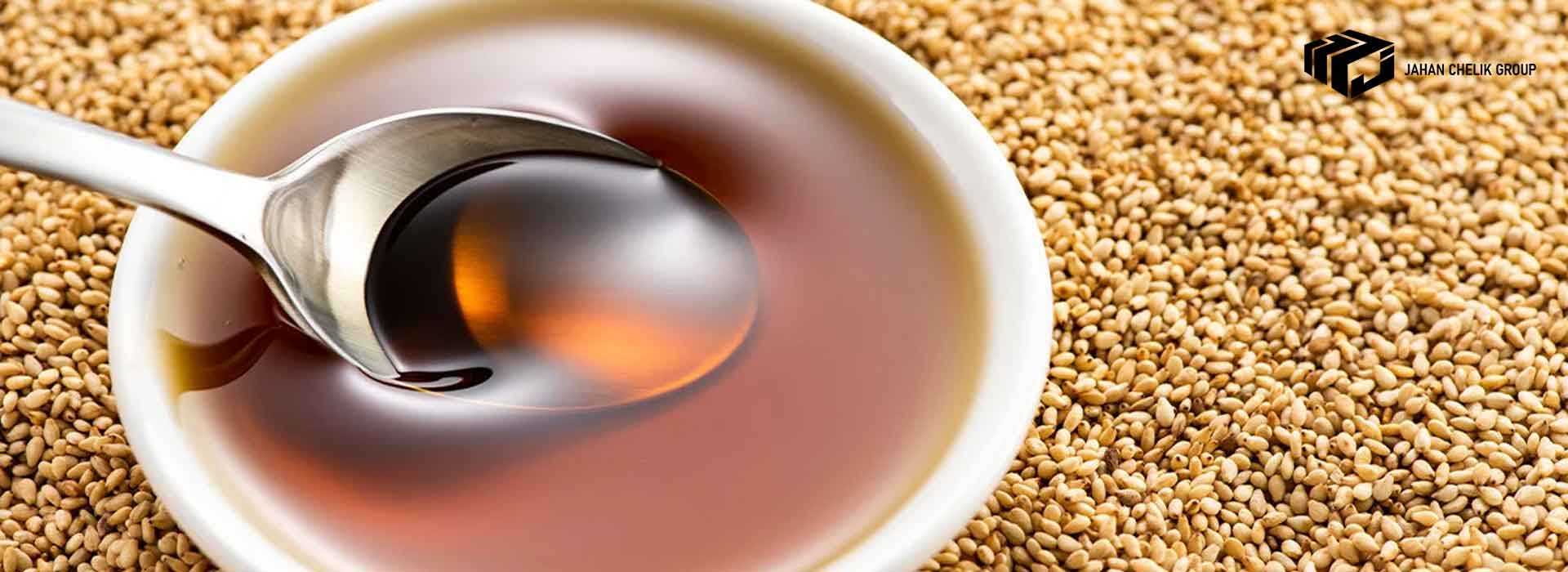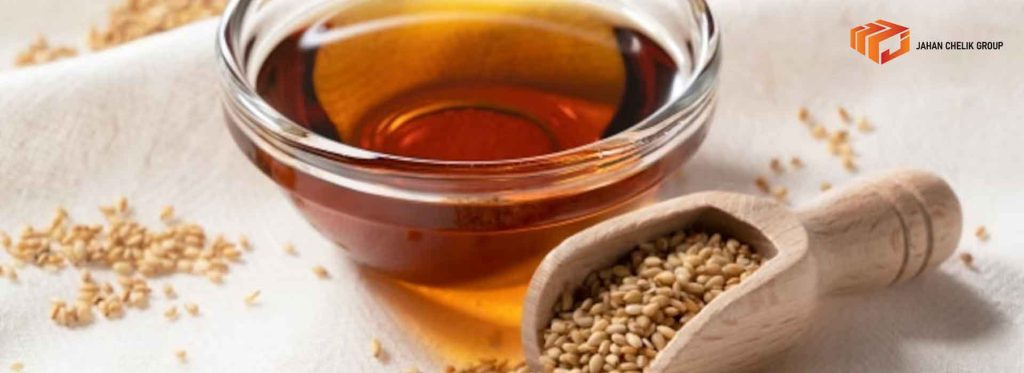Examining the properties of sesame oil
Sesame oil is one of the valuable and healthy oils extracted from sesame seeds. This oil is used all over the world due to its superior nutritional properties and unique taste. In this article, we will examine the steps of production to packaging of sesame oil so that the audience will get to know comprehensive and attractive information about this process.
Production of sesame seeds
The production of sesame seeds is a step-by-step process that requires careful care and agricultural knowledge. In the following, we discuss the production steps of sesame seeds:
Land selection
- Choosing the right land for planting sesame seeds is vital. Sesame needs a special soil that is loamy, with a neutral to alkaline pH and with proper drainage.
planting seeds
- Sesame seeds are usually sown directly in the ground. The amount of planting and suitable distances between seeds vary depending on the environmental conditions and soil type.
wATERING systems
- Sesame needs relatively little water, but proper and timely watering is very important during important periods such as germination and flowering.
Plant care
- During the growth of the plant, necessary care is taken to carry out pruning operations, pest and disease control, and weed management.
Picked up on time
- Harvesting sesame seeds at the right time is very important. Sesame seeds are ready to harvest when they have turned dark brown and the cotton inside is complete.
Drying the seeds
- Sesame seeds must be properly dried after harvesting. This step helps to prevent diseases and maintain the quality of the seeds.
Refinement and inspection
- After drying, the sesame seeds are refined and inspected to remove any unwanted shapes and particles.
These steps describe a step-by-step process of producing sesame seeds. Attention to detail in each step is very important to maintain high quality sesame seeds and nutritional properties.
To read and see the details of solid oil and its packaging, click on the orange link

Oil extraction
Extracting oil from sesame seeds is an important process that is carried out carefully to ensure that the oil is of high quality and properties are preserved. Below, we describe the steps of extracting oil from sesame seeds:
Preparation of seeds
- After harvesting and drying, sesame seeds enter the pre-preparation stage. This step includes removing the outer shell of the seeds and separating the unnecessary components.
Crushing the seeds
- Sesame seeds go to the crushing stage after pre-preparation. This step increases the contact surface of the seeds with the solvents (such as vegetable oils) that are used in the next steps for extraction.
Solvent extraction
- Sesame oil is extracted from the seeds using a solvent (such as hexane, isohexane, or ethanol). This step is often referred to as solvent extraction. Using its properties, the solvent penetrates the seeds and separates the oil from them.
Solvent distillation
- After extraction, the solvent used to separate the oil from it is distilled from the oil. This step helps purify the oil from the remaining solvent.
oil purification
- Extracted oil requires further purification to remove many components that may be introduced during extraction. This process includes refining and filtration.
Unloading and packing
- After purification, the sesame oil is discharged. This stage includes pumping and transporting the oil to the production site for final packaging. The packaging should be such that it protects from air, light and other external factors to maintain the quality of the oil.
All these steps are done carefully so that sesame oil is preserved with nutritional properties and suitable for consumption.
Purification and refinement
Sesame oil purification and refining stage is one of the vital stages that has a direct impact on the final quality of the oil. At this stage, the main goal is to remove any particles in the oil, increase its stability, and preserve its nutritional properties. Below, we explain the steps of refining and refining sesame oil:
Basic behavior
- Oil extracted from sesame seeds may contain small particles, extra coloring, solids, and even residual solvents. At this stage, the oil is fed into a tank to slowly flow into it.
Primary refinement
- In this step, equipment such as settlers, centrifuges, or other filters are used to separate larger particles from the oil. This process is designed to effectively separate solid particles from the oil.
Purification by filters
- Different filters with different grains and different filtration power are used to separate smaller particles. These filters may be made of different materials such as cellulose paper or synthetic materials.
Purification using detergents
- Some methods use detergents to remove smaller, unseparated particles from the oil. Detergents are substances that adhere to particles and separate these particles with the help of mechanical currents or other purification mechanisms.
Final purification
- In the final step, advanced techniques such as optical selection (illuminator) or special processes can be used to remove specific species of particles.
Quality testing
- After refining, the oil may be subjected to quality tests. These tests may include measuring acidity, color, odor, and other quality characteristics.
Unloading and packing
- After the final treatment, the oil is discharged to an environment that is prepared for final production and packaging. The packaging should be such as to prevent any further contamination and maintain the quality of the oil.
All these steps are carried out with the cooperation of experts and the use of modern equipment to produce high quality sesame oil with preserved properties.
To see the types of packaging and Haleb Oil, click on the orange link

packing
The packaging stage plays a very vital role in the production of sesame oil, because this stage has a great impact on the shelf life, quality, and safety of the product. Below, we describe the important stages of sesame oil packaging:
Choosing the right box or glass
- To package sesame oil, it is important to choose the right box or high quality jars. This packaging should be resistant to light, heat, and moisture to prevent oil oxidation.
Cleaning and disinfection
- Before packaging, all parts related to packaging must be carefully cleaned and thoroughly disinfected to avoid any contamination.
Bottle installation and decoration
- Sesame oil may be packaged in a variety of bottles, including plastic or glass. The packaging should be decorated with necessary information such as production date, nutritional information, and how to consume.
Observance of standards
- When packaging, it must be ensured that the product complies with local and international health standards and regulations.
History of contraception
- The production date and expiration date of sesame oil should be clearly displayed on the package and updated regularly.
Protection from light and heat
- Some packaging prevents the damaging effects of light and heat on the oil. Dark or frosted boxes or jars may be used to protect the oil from light.
Labeling and information
- The label should contain detailed information about the contents, effective dosage, contact information for the manufacturer, and any relevant warnings.
Quality control tests
- Before being released to the market, the packaging and oil must support various quality tests to ensure product quality assurance.
Protective packaging
- Adding memory materials to packaging (such as vacuum packs) may help preserve the freshness and quality of the oil.
Packaging, as the last connection point with the consumer, plays an essential role in gaining customer satisfaction and trust. For this reason, it is inevitable that this step be done with care and attention.
short
Sesame oil is one of the popular products around the world with its delicious taste and many nutritional properties. From the production of sesame seeds to the careful packaging, every step of the process plays a vital role in creating a high quality product. The information obtained from this article can help consumers make better choices for their health and benefit from sesame oil as an essential component in their daily nutrition.
The secret of health and unique taste
Sesame oil packaging with Jahan Chelik brand is known as a unique choice in the health world. This packaging has placed pure and high-quality sesame oil in the arms of a stylish and hygienic bottle using simple raw materials and the superiority of modern technology.
Attractive packaging design that matches the brand identity, including the cultural and natural details of Chalik world, shows the quality and credibility of the product. This packaging is beyond ordinary and emphasizes on preserving the natural properties and freshness of sesame oil. Taking advantage of this packaging means choosing a health and pleasure experience for consumers, where simplicity and quality meet each other and every drop of oil, It tells a story of attention to detail and quality.



